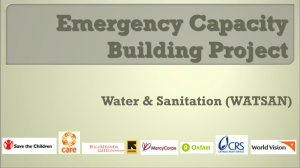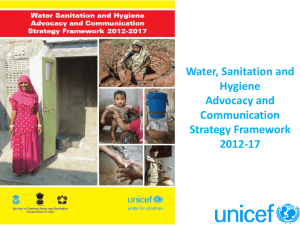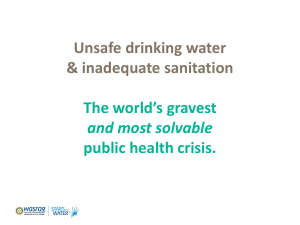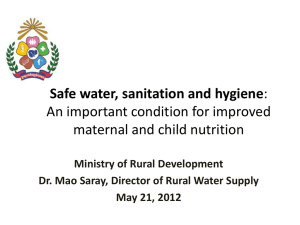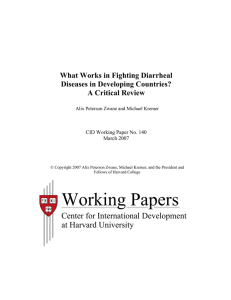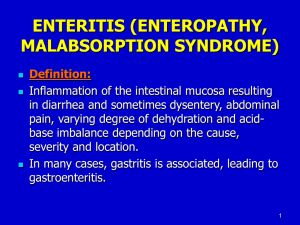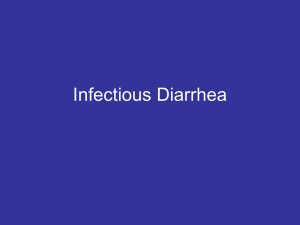- National Press Foundation
advertisement
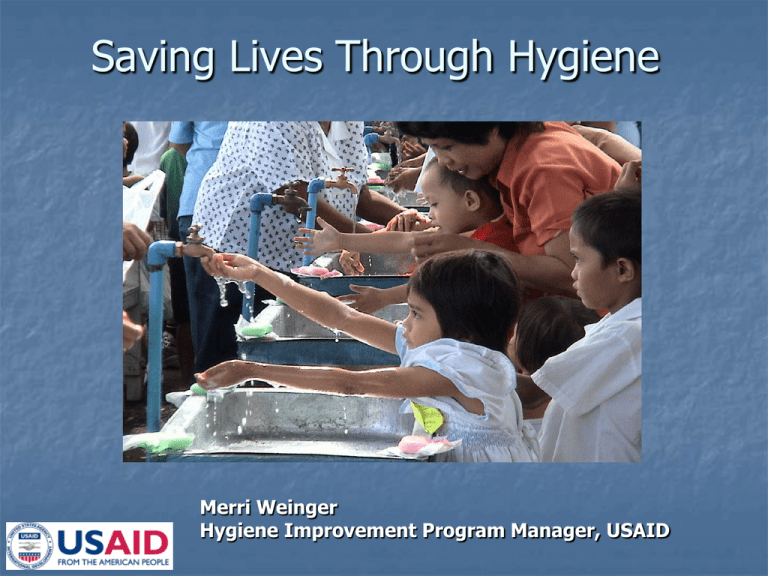
Saving Lives Through Hygiene Merri Weinger Hygiene Improvement Program Manager, USAID 1. What percentage of the 1.5 million annual child deaths caused by diarrhea are preventable? a. 0%-30% b. 31%-60% c. 61%-80% d. over 80% In what regions of the world does the majority of child mortality from diarrhea take place? Where do children < 5 die from diarrhea? LAC Middle East East Asia South Asia subSaharan Africa countriesaccount accountfor forover over70% 70%ofofthe theapproximately annual deaths 1111 countries globally from diarrhea 1.52 million global deaths from diarrhea annually 400,000 300,000 200,000 90% of deaths are in children 100,000 di N a ig e Pa ria ki st an D R C Ba Ch ng ina la de Et sh hi op i An a Af gh gol an a is In tan do ne Ta sia nz an ia 0 In Deaths from diarrhea 500,000 Source: Safer water, better health (WHO, 2008) 2. Out of the total world population of over 6.5 billion, how many people around the globe lack access to safe water? a. 50 million b. 500 million c. about 1 billion d. more than 2 billion WHO/UNICEF, 2010 8 3.How many people in the world lack access to hygienic sanitation facilities? a. 2.6 million b. 26 million c. 260 million d. 2.6 billion WHO/UNICEF, 2010 10 4. The only sure way to prevent diarrheal diseases is to ensure that all households have access to water and sanitation facilities. True _________ False_________ False! 5. Which of the following are among the recognized globally important hygiene behaviors for diarrhea prevention? (check all that apply) __ keeping food safe from contamination __ bathing daily __ effective handwashing __ washing feet before entering the home __ hygienic disposal of human feces __ face washing once a day __ clearing brush near the house __ safe water handling, transport, and storage Safe Feces Disposal Handwashing Safe Storage & Treatment of Water Hygiene Behaviors to Prevent DD (WHO, 1992) Keeping drinking water clean Keeping hands clean Keeping the environment clean (sanitation perspective) Keeping food clean Primary Prevention The F-Diagram Fluids Fields Food Feces Flies Fingers Source: Wagner and Lanois, 1958 New Host Primary Prevention The F-Diagram Fluids Water Quality Fields Food Feces Flies Fingers Source: Wagner and Lanois, 1958 New Host Primary Prevention The F-Diagram Fluids Water Quality Fields Food Feces Flies Fingers Source: Wagner and Lanois, 1958 Water Quantity New Host Primary Prevention The F-Diagram Sanitation Fluids Water Quality Fields Food Feces Flies Fingers Source: Wagner and Lanois, 1958 Water Quantity New Host Primary Prevention The F-Diagram Sanitation Fluids Water Quality Fields Food Feces Flies Fingers Water Quantity Hand Washing Source: Wagner and Lanois, 1958 New Host 6. Key WASH interventions will reduce diarrheal disease by a. 0-20% b. 21-50% c. 51-80% d. over 80% POU water treatment - 30-50% reduction in child DD prevalence – twice as effective as interventions at water source Safe storage – 21% reduction Proper handwashing - 43% reduction Sanitation – basic, low-cost systems can reduce DD by 30% or more 7. Name three reasons why household drinking water can often be unsafe for human consumption. Transport Handling, and Storage 8.What are effective methods for water disinfection at the point-ofuse? Household Water Treatment Options Chlorination PuR Ceramic Filtration Biosand Filtration Solar/SODIS Boiling 9. What are the critical times for handwashing with soap (or soap substitute) for diarrhea prevention? Critical Times for Handwashing with Soap After defecation After cleaning a baby’s bottom Before preparing food/cooking Before eating/feeding a baby 10. Which of the following are effective ways of promoting latrines? • Public financing and distribution of latrines to all households • Public shame • Demand creation (e.g. Community-Led Total Sanitation) • Develop partnerships with private sector producers of sanitation technologies (e.g. Sanitation Marketing) Increasing Demand for Sanitation MAY NOT DEPEND ON HEALTH MOTIVATIONS… RESPECT, PRESTIGE PERSONAL COMFORT, SELF-ESTEEM WHAT FACTORS BESIDES HEALTH MOTIVATED SANITATION ADOPTION IN THIS COMMUNITY? No Toilet, No Bride The "No Toilet, No Bride” program in the Indian state of Haryana has been the most successful sanitation promotion effort there so far. Started about two years ago, the campaign has resulted in 1.4 million latrines being built. "I will have to work hard to afford a toilet. We won't get any bride if we don't have one now," said 22-year-old villager Harpal Sirshwa from Nilokheri, who is hoping to marry soon. "I won't be offended when the woman I like asks for a toilet." 11. What are the best entry points for integrating hygiene improvement into existing health and development programs? Child health HIV/AIDS Teacher training Food Security and Nutrition Avian flu Education Antenatal and neonatal care USAID/GH Supported Partners in Hygiene Improvement CDC: Safe Water System www.cdc.gov/safewater/ International Network to Promote Household Water Treatment and Safe Storage www.who.int/household_water/network/en/ Global Public-Private Partnership For Handwashing with Soap www.globalhandwashing.org For further information, contact: Merri Weinger (Hygiene Improvement) mweinger@usaid.gov; 202-712-5102
